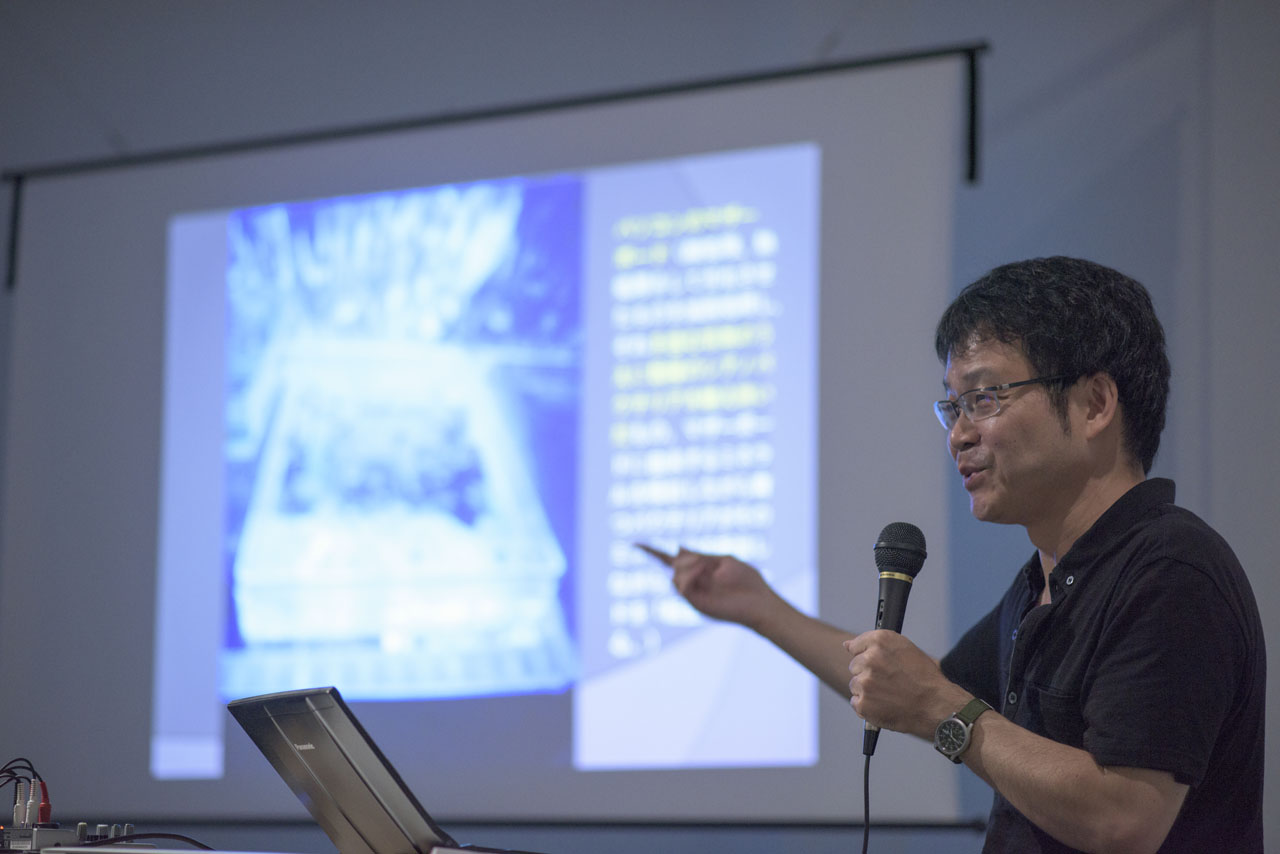だいちの星座はなぜわたしを惹きつけるのか
秋庭史典[名古屋大学大学院情報学研究科 准教授]
だいちの星座が面白いのは、そこに何重もの反転(ひっくり返し)があるからだ。タイトルがすでにそうである。星座は天空に、それが常識だろう。さらにこのタイトルには、「大地に描かれた星座」というだけでなく、「人工衛星だいち2号」による星座、という意味がある。そのことを知れば、人はもうひとつの反転を経験することになる。なぜか。
人工衛星を用いた映像の歴史はすでに長い。そのなかには、芸術あるいはアートに関わるものもかなり含まれている(Wilson2002, 坂根, 2010)。けれども、トム・ヴァン・サントの作品などを除き、その多くは宇宙の姿を記録したものである。に対し、だいちの星座は、文字通り、大地の姿を記録している。そのこと自体がひとつの大きな反転だ。が、それだけではない。大地の姿の記録がもつ意味、それを取り巻く文脈が、かつてとだいちの星座とでは、かなり異なるのである。どういうことか。
イームズ夫妻の《パワーズ・オブ・テン》(1968)。この著名な作品に、空から見た地上の姿が含まれていることは、だれでも知っている。しかしその映像は、いわゆるポスト・スプートニク時代の米ソ冷戦の記憶と強く結ばれている(Levin, Frohne, & Weibel, 2002)。そして世紀転換期、多くの衛星画像がもたらした地上の姿は、戦闘やテロによって荒廃した、あるいは環境汚染によって変わり果てた地上の姿を示していた(同)。衛星画像は、芸術においても、軍拡、監視、見えない恐怖の観点から語られてきたのだ。しかし、だいちの星座はそうではない。それは、そこに人が生きていること、たしかな命の営みがあることを知らせている。このことがいまのわたしたちにとって、とりわけ重要な反転であることは、疑いがない。
もうひとつの反転がある。それは、プロジェクトだいちの星座を成り立たせているのは誰か、に関わる。21世紀に入ると、さまざまな作家が、衛星画像だけでなく地上的感覚では得られない種々の可視化手法を用い、宇宙や地球環境をテーマにした作品を発表するようになる(四方, 2010)。情報技術環境の劇的な変化は、かつて特定の大規模機関にしかできなかったリサーチを、個人やグループが行うことを可能にした。しかしそれでもこうした作品の主体は、高度な情報処理技術を持った特定の人々つまりアーティストやアーキテクトたちであった。しかし、だいちの星座は違う。それを支えるのは、大地に生きるすべての人々なのである。リフレクタさえ用いれば、誰でもこの星座に参画することができる。そのリフレクタは、長年の実験改良の結果、どこででも、またどんな人でも組み立てることができるようになっている。しかも差分解析の結果彼らが見るのは、自分たちの姿ではない。彼らが見るのは、自分たちが描いた「絵」である。別の言い方をすれば、自分たちがかつてその一部となってつくりあげた、自分たちを超えるものとの、つまり宙(そら)からのまなざしとの「交わりのしるし」なのであり、そのことにこそ、驚きや喜び、そして美があるのだ。
このように、いくつもの反転を引き起こし、人の心や行動を変えながらも、だいちの星座プロジェクトがその場所自体に手を加えることはない。この節度が反転を支えている。自然、システム、人工物からなる大規模ネットワークの一部となりそこに干渉することがアートの主要な活動の一つとなっている現在、この節度が重みを持つのである。
[文献]
● 坂根巌夫(2010)『メディアアート創世記─科学と芸術の出会い』工作舎
● 四方幸子(2010)「ミッションG:地球を知覚せよ!」『JunCture』01、名古屋大学大学院文学研究科附属日本近現代文化研究センター、pp.7-12
● Thomas Y. Levin, Ursula Frohne, Peter Weibel (2002),
CTRL[SPACE]: Rhetorics of surveillance from Bentham to
Big Brother
● Wilson, S. (2002), Information Arts: Intersections of art, science,
and technology
秋庭史典
1966年生まれ。岡山大学文学部、京都大学大学院文学研究科博士後期課程修了。京都大学助手、島根大学法文学部助教授を経て現職。博士(文学)。著書「あたらしい美学をつくる」(2011)など。
Why Constellations of the Earth Captivates Me
Fuminori Akiba [Associate Professor, Graduate School of Informatics, Nagoya University]
What is interesting about Constellations of the Earth is the multiple layers of inversion. Its very title is one example: usually, it is a given that constellations belong up in the sky. As well as meaning a “constellation drawn on Earth,” this title has another sense: a constellation created by the artificial satellite Daichi (Daichi means “Earth” in Japanese). Knowing this creates yet another inversion, for the following reason.
There is already a long history of using footage from artificial satellites, including a considerable number of projects related to art (Wilson, 2002; Sakane, 2010). However, with the exception of works such as those by Tom Van Sant, most of them are recorded images of outer space. In contrast, as the title suggests, Constellations of the Earth records images of the Earth. This in itself is a major inversion; but there is more. The significance of a visual record of the Earth, and the context surrounding such records, differ radically in previous works and in Constellations. How exactly?
Consider Powers of Ten (1968) by Charles and Ray Eames. It is common knowledge that this renowned work included an image of the Earth as seen from the sky; however, this visual work is strongly tied to the memory of the post-Sputnik era during the Cold War (Levin, Frohne, & Weibel, 2002). And around the turn of the century, many pictures of the Earth captured through satellite imaging showed the land devastated by warfare and terrorism, or transformed by environmental pollution (Ibid.). Even in art, then, satellite images were handled in the context of military expansion, surveillance, and invisible fears. Not so with Constellations of the Earth, whose images of land illustrate that people live there, that there is real life going on there. This is beyond doubt a particularly important inversion for us in today’s world.
There is another inversion regarding the question of who brought the project Constellations of the Earth into being. After the start of the 21st century, various artists began to release works on the theme of space or of the Earth’s environment, using not just satellite imagery but a range of alternative methods to visually express elements that are hard to perceive down on the ground (Shikata, 2000). Dramatic changes in the IT environment enabled individuals and groups to conduct research that once could have only been handled by particular large-scale institutes. Nevertheless, these works were primarily driven by specific people with advanced information-processing technology, namely artists and architects. The case is different with Constellations, which is supported by everyone who inhabits the land. With a reflector, anyone can participate in this constellation. The reflectors, which have been honed through many years of trial and improvement, can be assembled anywhere by anyone. Moreover, the difference analysis does not yield an image of themselves, but a picture that they themselves drew. To look at it another way, the image produced is a symbol of their interaction with something beyond their reach – with a gaze from the sky – which they themselves once took part in creating. That is where lies the surprise, the joy, the beauty.
Through all these numerous inversions, the Constellations of the Earth project alters people’s thoughts and behavior – but without ever altering the physical setting itself. It is this moderation that points up the inversions. In today’s world, when it has become one of the key missions of art to be a part of, and interfere in, the giant network consisting of nature, systems and artifacts, there is dignity in such moderation.
[Bibliography]
● Levin, T., Frohne, U., Weibel, P. (Eds.) (2002). CTRL [SPACE]:
Rhetorics of Surveillance from Bentham to Big Brother.
● Sakane, I. (2010). The Origins of Media Arts, Kosakusha.
● Shikata, Y. (2010). “Mission G: sensing the earth,” JunCture, 1,
Nagoya University, Graduate School of Letters Research Center
for Modern and Contemporary Japanese Culture. pp.7-12.
● Wilson, S. (2002). Information Arts: Intersections of Art, Science,
and Technology.
Fuminori Akiba
Born in 1966, Akiba graduated from Okayama University’s Faculty of Letters, then earned his doctorate at Kyoto University’s Graduate School of Letters. After serving as an assistant at Kyoto University, and as assistant professor at the Faculty of Law & Literature at Shimane University, he assumed his current post. Akiba has a doctorate in literature, and his publications include Atarashii bigaku wo tsukuru (Creating New Aesthetics; 2011).

No responses yet